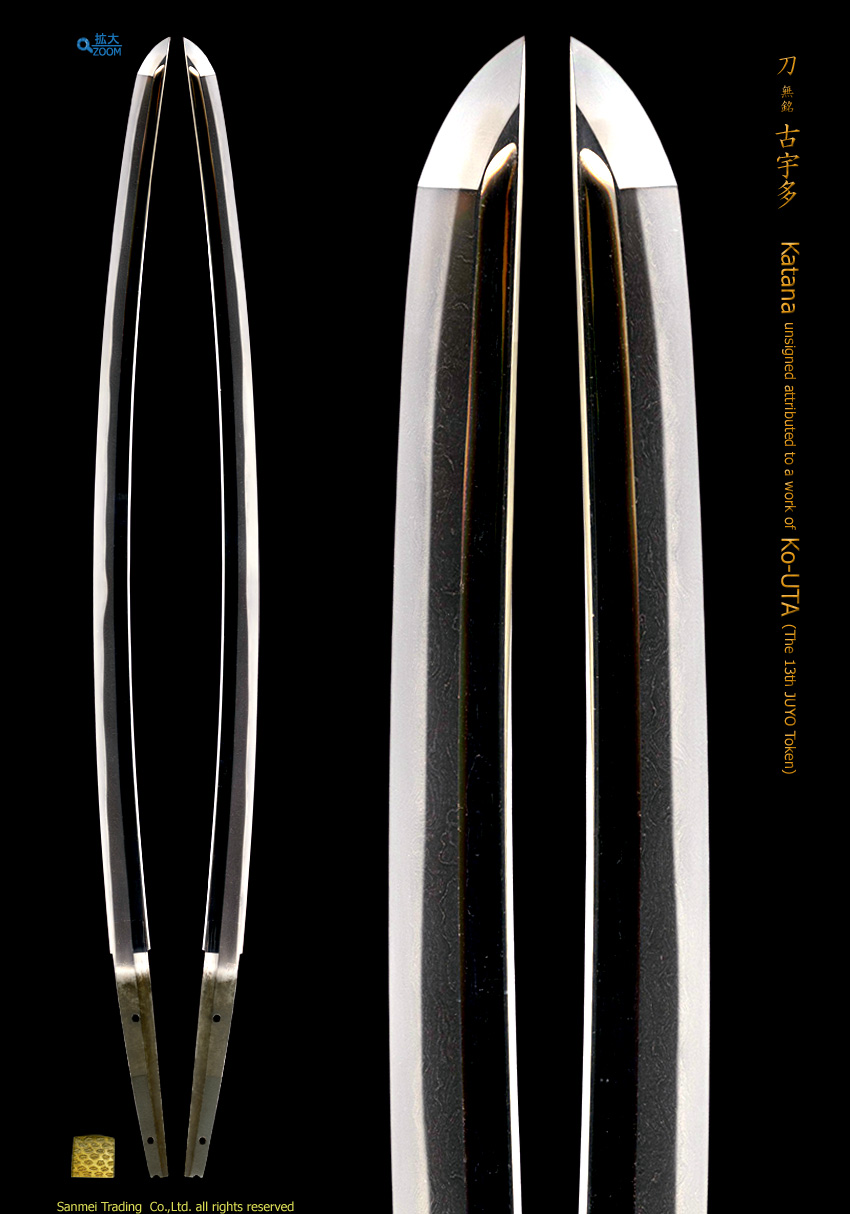Length of cutting edge 70.3cm Curvature 2.3cm Width of base 31.1mm Width of Yokote 20.8mm Thickness of base 6.8mm
Carving (Horimono) : There is wide and deep Bo-hi groove on both sides which is chiselled away to Nakago. Leaves an honored trace of hitting on the back ridge of Mune at 27.3cm down from Kissaki.
Forging(Hada) : Jigane is a bit on bluish side. Hada is conspicuous Itame and entwined flowing Masame grain marks mostly appears along quenching side. Abundant martensite crystals Ji-nie appears against well refined Jigane to generate profuse black gleaming lines of Chikei all over the surface even into the quenching boundary line.
Temper(Hamon) : Deep and thickly covered with abundant martensite crystals a bit on dimmed side Nie, shallow wavy of Notare mixing with small Gunome. Interior of temper is frequently active with thinner lines of Sunagashi and thick lines of Kin-suji.
Temper of tip(Boshi): Small circle turn back with an indication of sweeping layers Hakikake.
Tang(Nakago) : Ō-suriage substantially shortened unsigned. Upper the Nakago indicates horizontal Kiri file marks and lower original area shows Katte-sagari (shallow slanting left). Two Mekugi-ana (retaining holes) with a half-moon punch at the bottom end.
Uta-school sources to founder KUNIMITSU 国光 who came from Uta-gun, Yamato in Bunpo (1317-) era to Echu domain during Kamakura period. Representative makers KUNIFUSA 国房, KUNIMUNE 国宗 and KUNITSUGU 国次 were active during Nanbokucho period and their descendants had been prospered by end of Muromachi period.
For those works on before Nanbokucho period are named for Ko-UTA 古宇多 and the ones from Muromachi are called UTA 宇多.
For the reason of their origin from Yamato school, their workmanship mostly features Yamato tradittion. However Soushu technique rose in power to be a major majority, they learned Soushu-den from NORISHIGE 則重 - one of the 10 genius makers who belonged Masamune and some of their workmanship followed the works of SANEKAGE 真景 or TAMETSUGU 為継 in the same school of NORISHIGE.
This katana is Suriage shortened on about 2-sun (6cm) to be unsigned but it is still wide in Mihaba standing firmly on base holding harmonized deep curve that leads to a heroic medium Ikubi-style Kissaki which was in circulation end Kamakura period 14th C. The blade is impressively healthy and transcendent masterpiece to show key features of flourishing Sōshu technique with a background of basic tradition Yamato technique. It is convincing that this katana results in NBTHK the 13th JUYO awarded in 1965.
Recent polish/Condition scale: excellent (using a scale of mint-excellent-very good-good-fair-poor)
Gold foiled Botan- Yujo Habaki collar, preserved in Shirasaya plain wood mounting.


